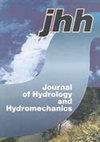Testing sensitivity of BILAN and GR2M models to climate conditions in the Gambia River Basin
IF 2.4
4区 环境科学与生态学
Q3 WATER RESOURCES
引用次数: 0
Abstract
This study investigates the performance of two lumped hydrological models, BILAN and GR2M, in simulating runoff across six catchments in the Gambia River Basin (Senegal) over a 30-year period employing a 7-year sliding window under different climatic conditions. The results revealed differences in overall performance and variable sensitivity of the models to hydrological conditions and calibration period lengths, stemming from their different structure and complexity. In particular, the BILAN model, which is based on a more complex set of parameters, showed better overall results in simulating dry conditions, while the GR2M model had superior performance in wet conditions. The study emphasized the importance of the length of the calibration period on model performance and on the reduction of uncertainty in the results. Extended calibration periods for both models narrowed the range of the Kling-Gupta Efficiency (KGE) values and reduced the loss of performance during the parameter transfer from calibration to validation. For the BILAN model, a longer calibration period also significantly reduced the variability of performance metric values. Conversely, for the GR2M model, the variability rate did not decrease with the length of the calibration periods. Testing both models under variable conditions underscored the crucial role of comprehending model structure, hydrological sensitivity, and calibration strategy effects on simulation accuracy and uncertainty for reliable results.测试 BILAN 和 GR2M 模型对冈比亚河流域气候条件的敏感性
本研究调查了 BILAN 和 GR2M 这两个总块水文模型在不同气候条件下模拟冈比亚河流域(塞内加 尔)六个集水区 30 年径流的性能,采用了 7 年滑动窗口。结果表明,由于模型的结构和复杂程度不同,模型的整体性能存在差异,对水文条件和校核期长度的敏感性也各不相同。特别是,基于更复杂参数集的 BILAN 模型在模拟干旱条件时显示出更好的整体效果,而 GR2M 模型在潮湿条件下则表现出色。研究强调了校准期的长短对模型性能和减少结果不确定性的重要性。两个模型的标定期延长,缩小了克林-古普塔效率(KGE)值的范围,减少了从标定到验证的参数转换过程中的性能损失。对于 BILAN 模型,较长的校准期也显著减少了性能指标值的变化。相反,对于 GR2M 模型,变异率并没有随着校准周期的延长而降低。在多变的条件下测试这两个模型,强调了理解模型结构、水文敏感性和校准策略对模拟精度和不确定性的影响对获得可靠结果的关键作用。
本文章由计算机程序翻译,如有差异,请以英文原文为准。
求助全文
约1分钟内获得全文
求助全文
来源期刊
CiteScore
4.20
自引率
5.30%
发文量
30
审稿时长
>12 weeks
期刊介绍:
JOURNAL OF HYDROLOGY AND HYDROMECHANICS is an international open access journal for the basic disciplines of water sciences. The scope of hydrology is limited to biohydrology, catchment hydrology and vadose zone hydrology, primarily of temperate zone. The hydromechanics covers theoretical, experimental and computational hydraulics and fluid mechanics in various fields, two- and multiphase flows, including non-Newtonian flow, and new frontiers in hydraulics. The journal is published quarterly in English. The types of contribution include: research and review articles, short communications and technical notes. The articles have been thoroughly peer reviewed by international specialists and promoted to researchers working in the same field.

 求助内容:
求助内容: 应助结果提醒方式:
应助结果提醒方式:


